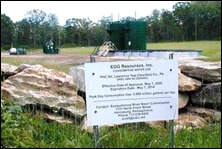PA Gas Well Blows Fracking Fluid into Old Growth Forest
by Sandy Bauer, PHYLLY.COM, June 13, 2010
 A 2006 blowout of a Fort Worth shale-gas well similar to those being drilled in the Marcellus killed a rig worker who had mistakenly opened a valve. It prompted the city to enact an ordinance doubling the 300-foot zone separating wells from occupied structures, to 600 feet.
A 2006 blowout of a Fort Worth shale-gas well similar to those being drilled in the Marcellus killed a rig worker who had mistakenly opened a valve. It prompted the city to enact an ordinance doubling the 300-foot zone separating wells from occupied structures, to 600 feet.
By Texas standards, the Punxsutawney Hunting Club blowout was isolated. Well 36H is on a four-acre pad that contains three other wells and is surrounded by eight square miles of club-owned forest.
EOG has about a dozen well pads on the club’s land and is developing more on an adjoining parcel of Moshannon State Forest, where it also controls mineral rights.
"It’s pretty desolate around here," said Gary L. Stonbraker, a club officer who lives in a cabin there in the summer. His neighbors are mostly elk, deer, a bear, and wild turkey. The nearest year-round dwellings on private land are three miles away.
Gas drilling is not making the hunting club rich. When it acquired its 4,700 acres in 1919, the mineral rights had already been separated by the previous owner, a timbering operation. The rights were acquired by Seneca Resources Corp., which partnered with EOG to develop the mile-deep shale.
The highland forests, mixed with an undergrowth of ferns and blossoming laurel, are now broken by a dozen four-acre well pads. EOG built a large impoundment area to contain the water injected into wells during the hydraulic-fracturing process. The water is delivered to the drilling sites through black plastic pipes that snake through the forest.
The company compensated the club for the disturbances. Members console themselves knowing that when the drilling is done, EOG is obliged to remove the surface pipes and water pond and revegetate the well pads. But drilling may go on for years.
"You can’t say it has had no effect on us," said Stonbraker, a retired school administrator, who nevertheless had only praise for the way EOG has conducted itself, and kept the dirt roads repaired.
After the blowout, the state Department of Environmental Protection said, 35,000 gallons of fluid, mostly saltwater, were collected from the well pad. DEP said tests showed some contaminants that migrated off the well site appeared to be dissipating a week after the spill.
It would not be EOG’s first leak. DEP cited the company in August for a spill of drilling fluids from a lined pit at a hunting club well site. [Read rest of story]


